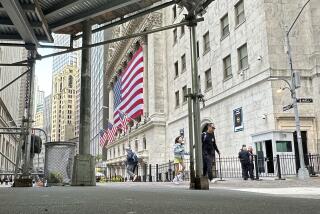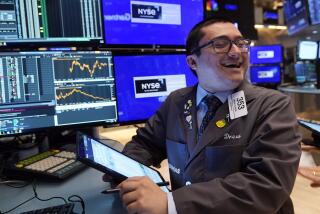Stock Market Steadies After a Jittery Start
NEW YORK — After worse-than-expected U.S. trade deficit figures set the stock market off to a jittery start Tuesday, stock prices firmed in relatively quiet trading, raising hopes that the markets are beginning to stabilize in the aftermath of Friday’s 190-point drop.
The Dow Jones industrial average ended the day down 18.65 points at 2,638.73, following an 88-point rise on Monday. The Dow index briefly dropped more than 60 points early Tuesday after the Commerce Department disclosed that the U.S. merchandise trade deficit had widened sharply to $10.77 billion in August, over $1 billion more than many economists had predicted.
But with the sometimes erratic help of computer-driven program trading, the market recovered much of the lost ground and traded in a relatively narrow range throughout the afternoon in New York. Volume on the New York Stock Exchange was 224.07 million shares, slightly more than half the extraordinarily heavy 416.29 million shares that changed hands Monday.
“I do think things are calming down,” said Jack Conlon, who is in charge of U.S. stock trading for Nikko Securities International in New York. Referring to Tuesday’s 18.65-point decline, he said that “after the rally that we had Monday, you were bound to get some kind of correction.”
Technical analysts and investment strategists cautioned, however, that despite the ebbing fears of a crash, the markets remain fairly volatile. “This was still an emotional day, with plenty of ups and downs,” said John Connolly, chief investment strategist for the brokerage firm Dean Witter Reynolds. “You can’t really say we’re stable yet.”
Many predicted that in the coming weeks the Dow index will drop to or below its low of 2,569 on Friday before resuming any sustained rise. “We had a big down and a big up,” said Brad Weeks, a senior vice president in the stock trading department of Donaldson, Lufkin & Jenrette Securities. “Now we have to go back down and test to see if the lows of the market (on Friday) are really the floor.”
Traders predicted that one longer-term consequence of Friday’s panicky drop will be to keep individual investors away from the stock market. They said it has reinforced small investors’ fears of devastating price swings that began with the 508-point crash on Oct. 19, 1987. And they predicted that once the dust settles from the events of the last few days, stock market volume will drop back to the low levels of recent months that have made trading barely profitable for many brokerage firms.
A seat on the New York Stock Exchange was sold Tuesday for $436,000, the lowest price in four years. The price is considered an indication of profit expectations in the brokerage business.
In the shorter term, blue-chip stocks are expected to outperform more thinly traded issues as small investors stay on the sidelines and institutions concentrate on “quality” stocks. “Until the volatility subsides, trading is going to be dominated by institutions, and therefore blue chips will dominate the trading,” said Eugene Peroni, a technical analyst at Janney Montgomery Scott in Philadelphia.
In Tuesday’s trading, the steep drop in NYSE stock prices early in the day was led by airline shares, which have been hit hard since Friday’s news that an investor group that made a $6.75-billion bid to take over UAL Corp., parent company of United Airlines, had failed to obtain financing.
The Dow Jones average of 20 transportation stocks closed the day down 49.96 points, at 1,254.27, following a 102-point loss on Monday.
News reports early Tuesday that bankers weren’t coming to terms on loans to back a revised offer for UAL led to a trading halt in the stock because of an “order imbalance”--far more sellers than buyers. UAL’s stock later resumed trading and ended the day at $198, down $24.875. The stock had dropped $56 on Monday.
The UAL deal has been viewed by takeover speculators as an indicator of whether takeover deals in general are in trouble because of growing reluctance by banks and buyers of high-yield junk bonds to provide financing.
The stock of AMR Corp., the parent of American Airlines, continued to suffer from Monday’s announcement that real estate developer Donald J. Trump had withdrawn a $120-a-share offer for the company. The stock slid $3.75 a share on Tuesday to close at $73.25 after a fall of $22.125 on Monday.
Traders said continued action by the Federal Reserve on Tuesday to assure liquidity in the nation’s financial system helped to steady investors’ nerves. The Fed pumped $1.5 billion into the banking system to boost commercial banks’ cash reserves and demonstrate the Fed’s resolve to make sure that banks have enough cash on hand to meet the borrowing needs of Wall Street firms. The Fed on Monday had added $2 billion to the banks’ reserves. Market analysts said investors also were acting on the belief that the Fed may move soon to lower interest rates.
On the NYSE, declining stocks outnumbered rising issues by about 7 to 5, with 931 down and 658 up. The NYSE’s composite index of all stocks listed on the exchange dropped 0.87 to 188.89.
Officials at several large mutual fund concerns said Tuesday that the level of customer calls was gradually returning to normal. Tracy Gordon, a spokeswoman for Fidelity Investments in Boston, the nation’s largest mutual fund group, said the volume of calls from customers declined by about one-third from Monday’s level, adding that there were signs of increased interest by investors in stock funds.
Investment strategists and market analysts were divided Tuesday on the longer-term outlook for the market. Many noted an apparent slowdown in the economy and said the market may remain relatively depressed for the rest of the year, in part because many companies are now expected to report relatively weak third-quarter earnings. Others, however, said a softening economy in turn would lead to a significant lowering of interest rates by the Fed, which in turn could drive stock prices significantly higher.
RELATED STORIES: D1-2
More to Read
Inside the business of entertainment
The Wide Shot brings you news, analysis and insights on everything from streaming wars to production — and what it all means for the future.
You may occasionally receive promotional content from the Los Angeles Times.










